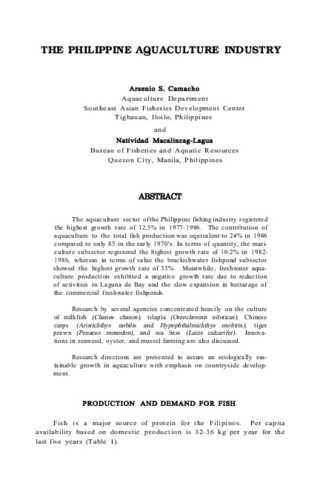Indonesia: Status of implementation of the resolution and plan of action on aquaculture
- Global styles
- MLA
- Vancouver
- Elsevier - Harvard
- APA
- Help
Share
抄録
Aquaculture has been the focus of fisheries development policy in Indonesia since the new Minister in the Ministry of Marine Affairs and Fisheries of Indonesia was decided in October 2009. The Ministry s vision is to increase aquaculture production up to 3.5 times for the period of five years (2009-2014) from 4.78 to 16.89 million mt (DGA 2009). The development of Indonesian aquaculture plays an increasingly important role in the country s economic growth through job creation and income generation, especially in rural areas. Several measures have been implemented to develop aquaculture, such as expansion of aquaculture areas, intensification of existing aquaculture facilities, production of good quality seeds, continued development of biotechnology for producing new species or strain, improved efficiency offered and use of locally available raw materials such as maggot meal, and development of technology on disease control using molecular tools. Also included are the improvement of farmer s education and awareness in implementation of Best management practices (BMPs) for sustainability, increased participation of farmers and private sector in aquaculture development, and provision of various financial schemes for aquaculture businesses.
Suggested Citation
Sugama, K. (2011). Indonesia: Status of implementation of the resolution and plan of action on aquaculture. In B. O. Acosta, R. M. Coloso, E. G. T. de Jesus-Ayson, & J. D. Toledo (Eds.), Sustainable aquaculture development for food security in Southeast Asia towards 2020. Proceedings of the Regional Technical Consultation on Sustainable Aquaculture Development in Southeast Asia Towards 2020 (pp. 73-81). Tigbauan, Iloilo, Philippines: Aquaculture Department, Southeast Asian Fisheries Development Center.
Type
Conference paperISBN
9789718511992
Related items
Showing items related by title, author, creator and subject.
-
Aquaculture in Malaysia
Kechik, Ismail bin Awang. (Aquaculture Department, Southeast Asian Fisheries Development Center, 1995)Aquaculture in Malaysia is experiencing rapid growth. Total production in 1992 amounted to 79,699 tons valued at RM 207.4 million. These figures are 23% and 25% higher than the previous year's. Semi-culture of the cockle ... -
Aquaculture development in Thailand
Sirikul, Boonsong; Luanprida, Somsak; Chaiyakam, Kanit; Sriprasert, Revadee (Aquaculture Department, Southeast Asian Fisheries Development Center, 1988)Aquaculture practised in Thailand is in the form of pond culture and cage culture in freshwater, brackishwater and coastal areas. The main species cultured include freshwater prawns, brackishwater shrimp, cockles, mussels, ... -
The Philippine aquaculture industry
Camacho, Arsenio S.; Macalincag-Lagua, Natividad (Aquaculture Department, Southeast Asian Fisheries Development Center, 1988)The aquaculture sector of the Philippine fishing industry registered the highest growth rate of 12.5% in 1977-1986. The contribution of aquaculture to the total fish production was equivalent to 24% in 1986 compared to ...






